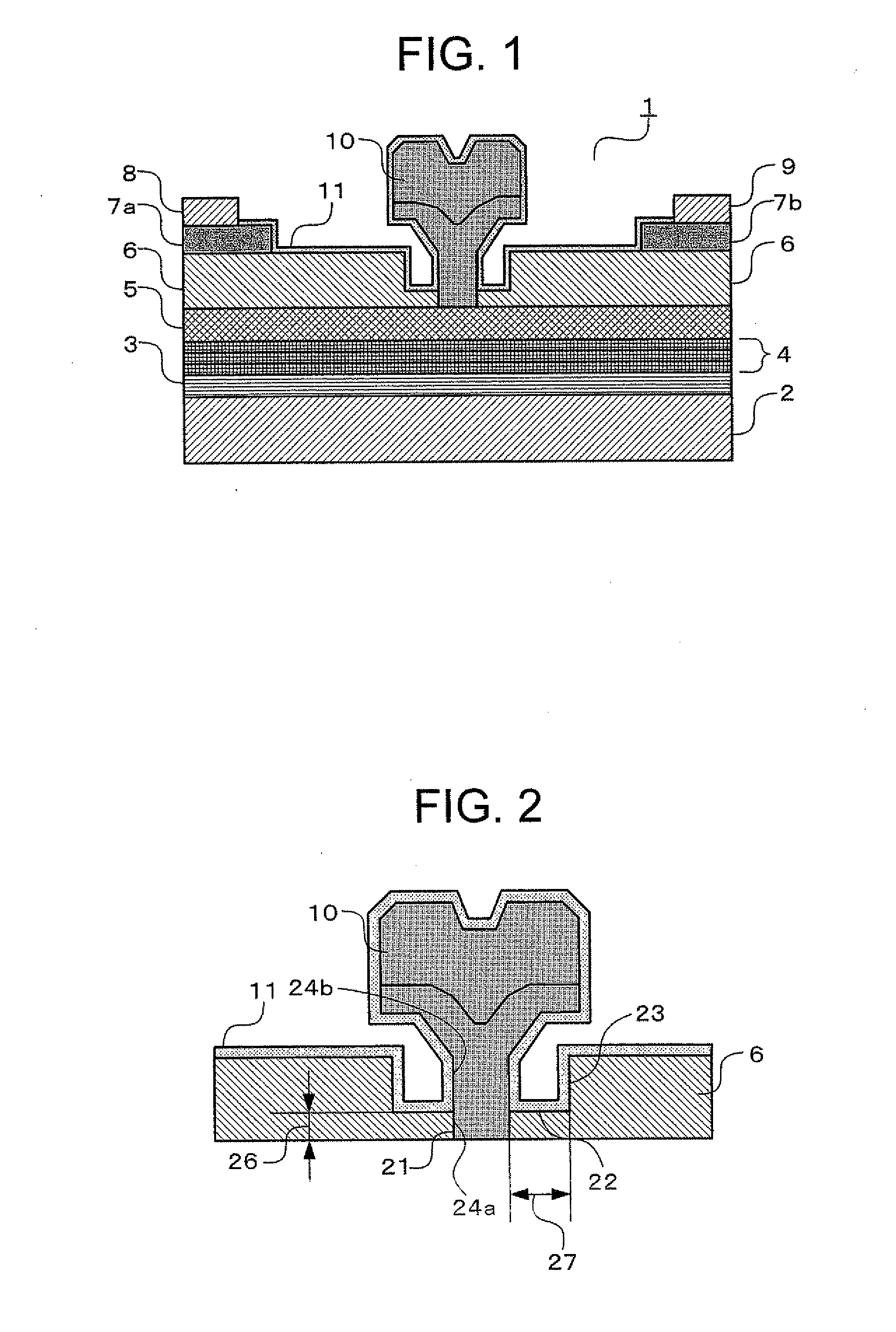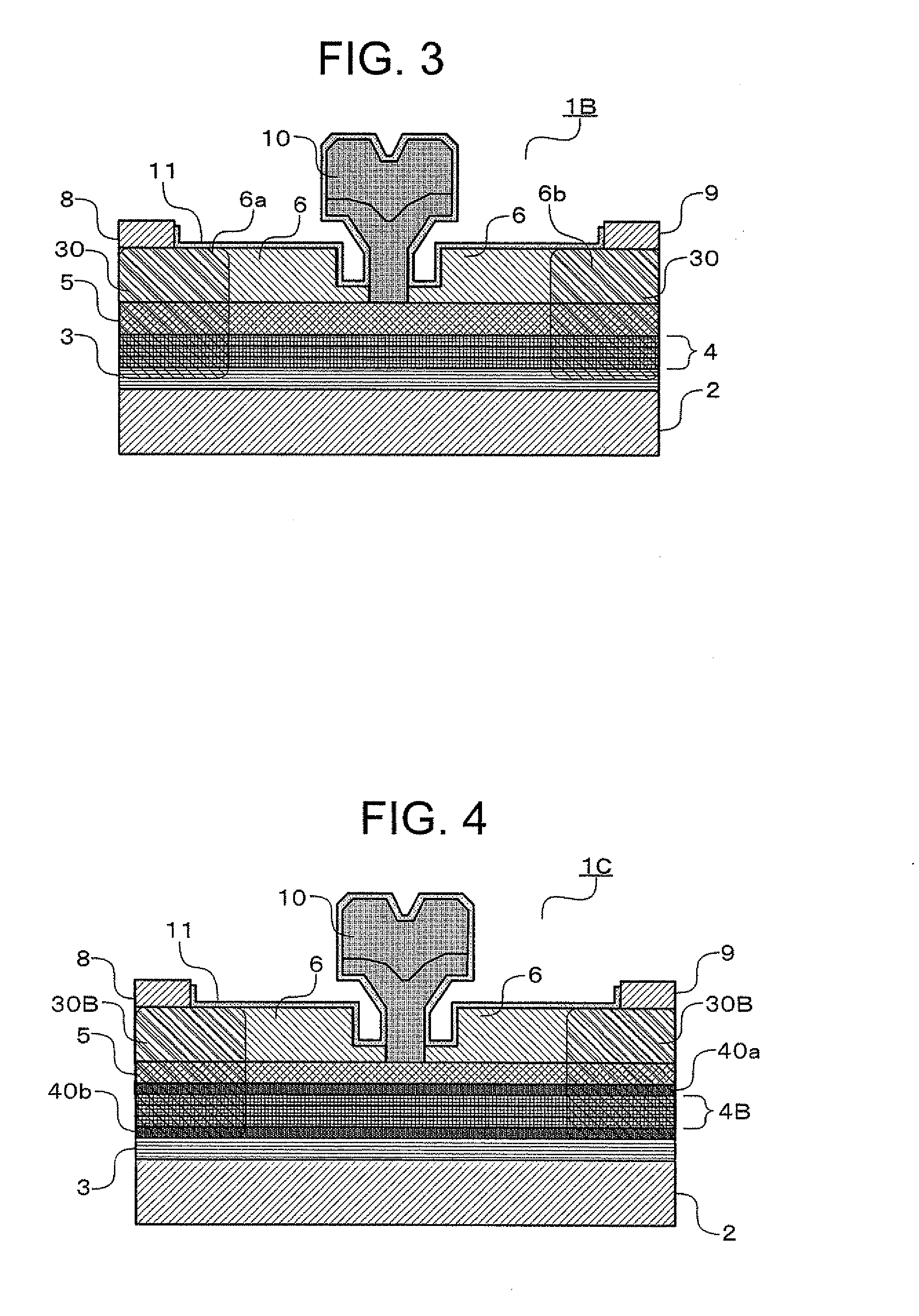Field-effect transistor
a field-effect transistor and transistor technology, applied in the field of field-effect transistors, can solve the problems of increasing gate leakage current, buried gate structure etc., and achieve the effects of suppressing gate leakage current, reducing the maximum drain current, and small leakage path
- Summary
- Abstract
- Description
- Claims
- Application Information
AI Technical Summary
Benefits of technology
Problems solved by technology
Method used
Image
Examples
first embodiment
[0022]FIG. 1 is a sectional view of a field-effect transistor according to a first embodiment of the present invention. FIG. 2 is an enlarged sectional view of a periphery of a gate electrode.
[0023]A compound semiconductor according to the present invention corresponds to a III-V compound semiconductor. In addition to GaAs and GaN, gallium phosphide (GaP), gallium antimonide (GaSb), indium nitride (InN), and indium phosphide (InP) can also be used as the compound semiconductor. Further, as a semi-insulating substrate, a substrate composed of the GaAs or InP can be used.
[0024]Hereinafter, description will be made using the GaAs as an example of the III-V compound semiconductor.
[0025]As shown in FIG. 1, a field-effect transistor 1 according to a first embodiment of the present invention includes a buffer layer 3, a channel layer 4, a gate contact layer 5, and a gate buried layer 6. The buffer layer 3 is formed of an undoped GaAs epitaxial layer grown on a semi-insulating GaAs substrat...
second embodiment
[0046]FIG. 3 is a sectional view of a field-effect transistor according to a second embodiment of the present invention.
[0047]A field-effect transistor 1B according to the second embodiment of the present invention is different from the field-effect transistor 1 according to the first embodiment in that the field-effect transistor 1B includes injection / anneal regions 30 in parts of a gate buried layer 6, a gate contact layer 5, and a channel layer 4 and does not include cap layers 7a and 7b. The other components of the field-effect transistor 1B are the same as those of the field-effect transistor 7 of the first embodiment, so the same components are denoted by the same reference numerals and the description thereof will be omitted.
[0048]As shown in FIG. 3, in the field-effect transistor 1B according to the second embodiment, regions 6a and 6b in the gate buried layer 6 and the injection / anneal regions 30 are formed. On the regions 6a and 6b, a source electrode 8 and a drain electro...
third embodiment
[0058]FIG. 4 is a sectional view of a field-effect transistor according to a third embodiment of the present invention.
[0059]A field-effect transistor 1C according to the third embodiment of the present invention is different from the field-effect transistor 1B according to the second embodiment in that the field-effect transistor 1C includes electron supply layers 40a and 40b and a channel layer 4B instead of the channel layer 4. The other components of the field-effect transistor 1C are the same as those of the field-effect transistor 1B of the second embodiment, so the same components are denoted by the same reference numerals and the description thereof will be omitted.
[0060]As shown in FIG. 4, the field-effect transistor 1C according to the third embodiment is a high electron mobility field-effect transistor (HEMT). The channel layer 4B is formed of an undoped InGaAs epitaxial layer in which conduction electrons move. Further, the field-effect transistor 1C according to the thi...
PUM
 Login to View More
Login to View More Abstract
Description
Claims
Application Information
 Login to View More
Login to View More - R&D
- Intellectual Property
- Life Sciences
- Materials
- Tech Scout
- Unparalleled Data Quality
- Higher Quality Content
- 60% Fewer Hallucinations
Browse by: Latest US Patents, China's latest patents, Technical Efficacy Thesaurus, Application Domain, Technology Topic, Popular Technical Reports.
© 2025 PatSnap. All rights reserved.Legal|Privacy policy|Modern Slavery Act Transparency Statement|Sitemap|About US| Contact US: help@patsnap.com



